Effectiveness of Push–Pull Systems to Fall Armyworm (Spodoptera frugiperda) Management in Maize Crops in Morelos, Mexico
Abstract
Simple Summary
Abstract
1. Introduction
2. Materials and Methods
2.1. Study Area Characterization
2.2. Experimental Design
2.3. Incidence and Severity of Spodoptera Frugiperda Damage
2.4. Morphoagronomic and Edaphoclimatic Variables in the Production Systems
2.5. Maize Grains and Green Forage Yields in the Systems
2.6. Comparative Analysis of Profitability of the Production Systems
2.7. Statistical Analysis
3. Results
3.1. Incidence and Severity of Fall Armyworm in the Evaluated Systems
3.2. Morphoagronomic and Edaphoclimatic Variables in the Production Systems
3.3. Maize and Forage Yields in the Production Systems
4. Discussion
5. Conclusions
Supplementary Materials
Author Contributions
Funding
Institutional Review Board Statement
Data Availability Statement
Acknowledgments
Conflicts of Interest
References
- Altieri, M. Bases Científicas Para una Agricultura Sustentable; Editorial Nordan–Comunidad: Montevideo, Uruguay, 1999; p. 338. [Google Scholar]
- Gliessman, S.R. Field and Laboratory Investigations in Agroecology, 3rd ed.; CRC Press: West Palm Beach, FL, USA, 2014; p. 256. [Google Scholar]
- Altieri, M.A.; Funes-Monzote, F.R.; Petersen, P. Agroecologically efficient agricultural systems for smallholder farmers: Contributions to food sovereignty. Agron. Sustain. Dev. 2012, 32, 1–13. [Google Scholar] [CrossRef]
- Álvarez, E.; Carreón, A.; San Vicente, A. Haciendo Milpa: La Protección de las Semillas y de la Agricultura Campesina; UNAM: Ciudad de México, Mexico, 2011; p. 104. [Google Scholar]
- Chen, Y.H.; Shapiro, L.R.; Benrey, B.; Cibrian-Jaramillo, A. Back to the origin: In situ studies are needed to understand selection during crop diversification. Front. Ecol. Evol. 2017, 5, 1–8. [Google Scholar] [CrossRef]
- Jiggins, J. Agroecology: Adaptation and Mitigation Potential and Policies for Climate Change. In Global Environmental Change; Springer: Dordrecht, The Netherlands, 2014; pp. 733–743. [Google Scholar]
- Rosset, P.M.; Altieri, M.A. Agroecología Ciencia y Política; Icaria Editorial: Barcelona, Spain, 2018; p. 206. [Google Scholar]
- Harrison, R.D.; Thierfelder, C.; Baudron, F.; Chinwada, P.; Midega, C.; Schaffner, U.; Van den Berg, J. Agro-ecological options for fall armyworm (Spodoptera frugiperda JE Smith) management: Providing low-cost, smallholder friendly solutions to an invasive pest. J. Environ. Manag. 2019, 243, 318–330. [Google Scholar] [CrossRef]
- D’Annolfo, R.; Gemmill-Herren, B.; Amudavi, D.; Shiraku, H.W.; Piva, M.; Garibaldi, L.A. The effects of agroecological farming systems on smallholder livelihoods: A case study on push–pull system from Western Kenya. Int. J. Agric. Sustain. 2020, 18, 1–15. [Google Scholar] [CrossRef]
- Pyke, B.; Rice, M.J.; Sabine, B.; Zalucki, M.P. The push-pull strategy—Behavioural control of Heliothis. Aust. Cotton. Grow. 1987, 8, 7–9. [Google Scholar]
- Miller, J.R.; Cowles, R.S. Stimulo-deterrent diversion: A concept and its possible application to onion maggot control. J. Chem. Ecol. 1990, 16, 3197–3212. [Google Scholar] [CrossRef]
- Khan, Z.R.; Midega, C.A.O.; Amudavi, D.M.; Hassanali, A.; Pickett, J.A. On-farm evaluation of the ‘push-pull’ technology for the control of stemborers and striga weed on maize in western Kenya. Field Crop. Res. 2008, 103, 224–233. [Google Scholar] [CrossRef]
- Midega, C.A.O.; Pittchar, J.O.; Pickett, J.A.; Hailu, G.W.; Khan, Z.R.A. Climate-adapted push-pull system effectively controls fall armyworm, Spodoptera frugiperda (J. E. SMITH), in maize in east Africa. Crop. Prot. 2018, 105, 10–15. [Google Scholar] [CrossRef]
- Khan, Z.R.; Pittchar, J.O.; Midega, C.A.O.; Pickett, J.A. Push-pull farming system controls Fall Armyworm: Lessons from Africa. Outlooks Pest Manag. 2018, 29, 220–224. [Google Scholar] [CrossRef]
- Hailu, G.; Niassy, S.; Khan, R.Z.; Ochatum, N.; Subramanian, S. Maize–Legume Intercropping and Push–Pull for Management of Fall Armyworm, Stemborers, and Striga in Uganda. Agron. J. 2018, 110, 1–10. [Google Scholar] [CrossRef]
- Guera, O.G.M.; Castrejón-Ayala, F.; Robledo, N.; Jiménez-Pérez, A.; Sánchez-Rivera, G. Plant Selection for the Establishment of Push–Pull Strategies for Zea mays–Spodoptera frugiperda Pathosystem in Morelos, Mexico. Insects 2020, 11, 349. [Google Scholar] [CrossRef]
- Climate-Data. Clima: Morelos. Available online: https://es.climate-data.org/ (accessed on 16 June 2019).
- Khan, Z.R.; Muyekho, F.N.; Njuguna, E.; Pickett, J.A.; Wadhams, L.J.; Pittchar, J.; Ndiege, A.; Genga, G.; Nyagol, D.; Lusweti, C. A Primer on Planting and Managing ‘Push-Pull’ Fields for Stemborer and Striga Weed Control in Maize: A Step-by-Step Guide for Farmers and Extension Staff, 2nd ed.; ICIPE Science Press: Nairobi, Kenya, 2007; 60p. [Google Scholar]
- Cooke, B.M. Disease assessment and yield loss. In The Epidemiology of Plant Diseases; Springer: Dordrecht, The Netherlands, 2006; pp. 43–80. [Google Scholar]
- Abbott, W.S. A method of computing the effectiveness of an insecticide. J. Econ. Entomol. 1925, 18, 265–267. [Google Scholar] [CrossRef]
- Watson, D.J. Comparative physiological studies in the growth of field crops. I. Variation in net assimilation rate and leaf area between species and varieties, and within and between years. Ann. Bot. 1947, 11, 41–76. [Google Scholar] [CrossRef]
- Monsi, M.; Saeki, T. On the factor light in plant communities and its importance for matter production. Ann. Bot. 2005, 95, 549–567. [Google Scholar] [CrossRef]
- Zamudio-González, B.; Espinosa-Calderón, A.; Tadeo-Robledo, M.; Encastín-Dionicio, J.J.; Martínez, J.N.R.; Felix-Reyes, A.; Cárdenas, M.A.L.; Turrent, F.A. Producción de híbridos y variedades de maíz para grano en siembra a doble hilera. Rev. Mex. Cienc. Agríc. 2015, 6, 1491–1505. [Google Scholar]
- Omokanye, A.; Yoder, C.; Sreekumar, L.; Vihvelin, L.; Benoit, M. Forage Production and Economic Performance of Pasture Rejuvenation Methods in Northern Alberta, Canada. Sustain. Agric. Res. 2018, 7, 94–110. [Google Scholar] [CrossRef][Green Version]
- Carrano-Moreira, A.F. Manejo Integrado de Pragas Florestais: Fundamentos Ecológicos, Conceitos e Táticas de Controle; Technical Books: Rio de Janeiro-RJ, Brazil, 2014; p. 349. [Google Scholar]
- González-Estrada, A. A Dynamic General Equilibrium Model of Mexico: Macroeconomic Dynamics under NAFTA. Ph.D. Thesis, Graduate School of the University of Minnesota, Minneapolis, MN, USA, 1999. [Google Scholar]
- Shapiro, S.S.; Wilk, M.B. An analysis of variance test for normality (complete samples). Biometrika 1965, 52, 591–611. [Google Scholar] [CrossRef]
- Levene, H. Robust Tests for Equality of Variances. In Contributions to Probability and Statistics: Essays in Honour of Harold Hotelling; Stanford University Press: Redwood, CA, USA, 1960; pp. 278–292. [Google Scholar]
- Gbur, E.E.; Stroup, W.W.; McCarter, K.S.; Durham, S.; Young, L.J.; Christman, M.; West, M.; Kramer, M. Analysis of Generalized Linear Mixed Models in the Agricultural and Natural Resources Sciences; ASA, CSSA, and SSSA: Madison, WI, USA, 2012; 283p. [Google Scholar]
- Chen, K.; Cheng, Y.; Berkout, O.; Lindhiem, O. Analyzing Proportion Scores as Outcomes for Prevention Trials: A Statistical Primer. Prev. Sci. 2017, 18, 312–321. [Google Scholar] [CrossRef]
- Bates, D.; Mächler, M.; Bolker, B.; Walker, S. Fitting Linear Mixed-Effects Models Using lme4. J. Stat. Softw. 2015, 67, 1–48. [Google Scholar] [CrossRef]
- Scott, A.J.; Knott, M. Cluster analysis method for grouping means in the analysis of variance. Biometrics 1974, 30, 507–512. [Google Scholar] [CrossRef]
- Jelihovschi, E.G.; Faria, J.C.; Allaman, I.B. ScottKnott: A Package for Performing the Scott-Knott Clustering Algorithm in R. Trends Appl. Comp. Math. 2014, 15, 3–17. [Google Scholar] [CrossRef]
- Borges, L.C.; Ferreira, D.F. Poder e taxas de erro tipo I dos testes de Scott-Knott, Tukey e Student-Newman-Keuls sob distribuições normal e não normais dos resíduos. Rev. Mat. Estat. 2003, 21, 67–83. [Google Scholar]
- Ferreira, D.F.; Muniz, J.A.; Aquino, L.H. Comparações múltiplas em experimentos com grande número de tratamentos—utilização do teste de Scott-Knott. Cienc. Agrotecnologia 1999, 23, 745–752. [Google Scholar]
- Le, S.; Josse, J.; Husson, F. FactoMineR: An R Package for Multivariate Analysis. J. Stat. Softw. 2008, 25, 1–18. [Google Scholar] [CrossRef]
- Yanhui Fan, F. FinCal: Time Value of Money, Time Series Analysis and Computational Finance. 2016. Available online: https://mran.microsoft.com/snapshot/2016-08-05/web/packages/FinCal/FinCal.pdf (accessed on 20 August 2020).
- R Core Team. R: A Language and Environment for Statistical Computing; R Core Team: Vienna, Austria, 2020. [Google Scholar]
- Njeru, N.K.; Midega, C.A.O.; Muthomi, J.W.; Wagacha, J.M.; Khan, Z.R. Impact of push–pull cropping system on pest management and occurrence of ear rots and mycotoxin contamination of maize in western Kenya. Plant Pathol. 2020, 69, 1644–1654. [Google Scholar] [CrossRef]
- Altieri, M.A. Diversification of corn agroecosystems as a means of regulating fall armyworm populations. Fla. Entomol. 1980, 63, 18–24. [Google Scholar] [CrossRef]
- Midega, C.A.O.; Bruce, T.J.A.; Pickett, J.A.; Pittchar, J.O.; Murage, A.; Khan, Z.R. Climate-adapted companion cropping increases agricultural productivity in East Africa. Field Crop. Res. 2015, 180, 118–125. [Google Scholar] [CrossRef]
- Midega, C.A.O.; Bruce, T.J.A.; Pickett, J.A.; Khan, Z.R. Ecological management of cereal stemborers in African smallholder agriculture through behavioral manipulation. Ecol. Entomol. 2015, 40, 70–81. [Google Scholar] [CrossRef]
- Ndayisaba, P.C.; Kuyah, S.; Midega, C.A.O.; Mwangi, P.N.; Khan, Z.R. Push-pull technology improves maize grain yield and total aboveground biomass in maize-based systems in Western Kenya. Field Crop. Res. 2020, 256, 1–12. [Google Scholar] [CrossRef]
- Khan, Z.; Midega, C.; Pittchar, J.; Pickett, J.; Bruce, T. Push–pull technology: A conservation agriculture approach for integrated management of insect pests, weeds and soil health in Africa. Int. J. Agric. Sustain. 2011, 9, 162–170. [Google Scholar] [CrossRef]
- Khan, Z.R.; Midega, C.A.O.; Njuguna, E.M.; Amudavi, D.M.; Wanyama, J.M.; Pickett, J.A. Economic performance of ‘push –pull’ technology for stem borer and striga weed control in smallholder farming systems. Crop Prot. 2008, 27, 1084–1097. [Google Scholar] [CrossRef]
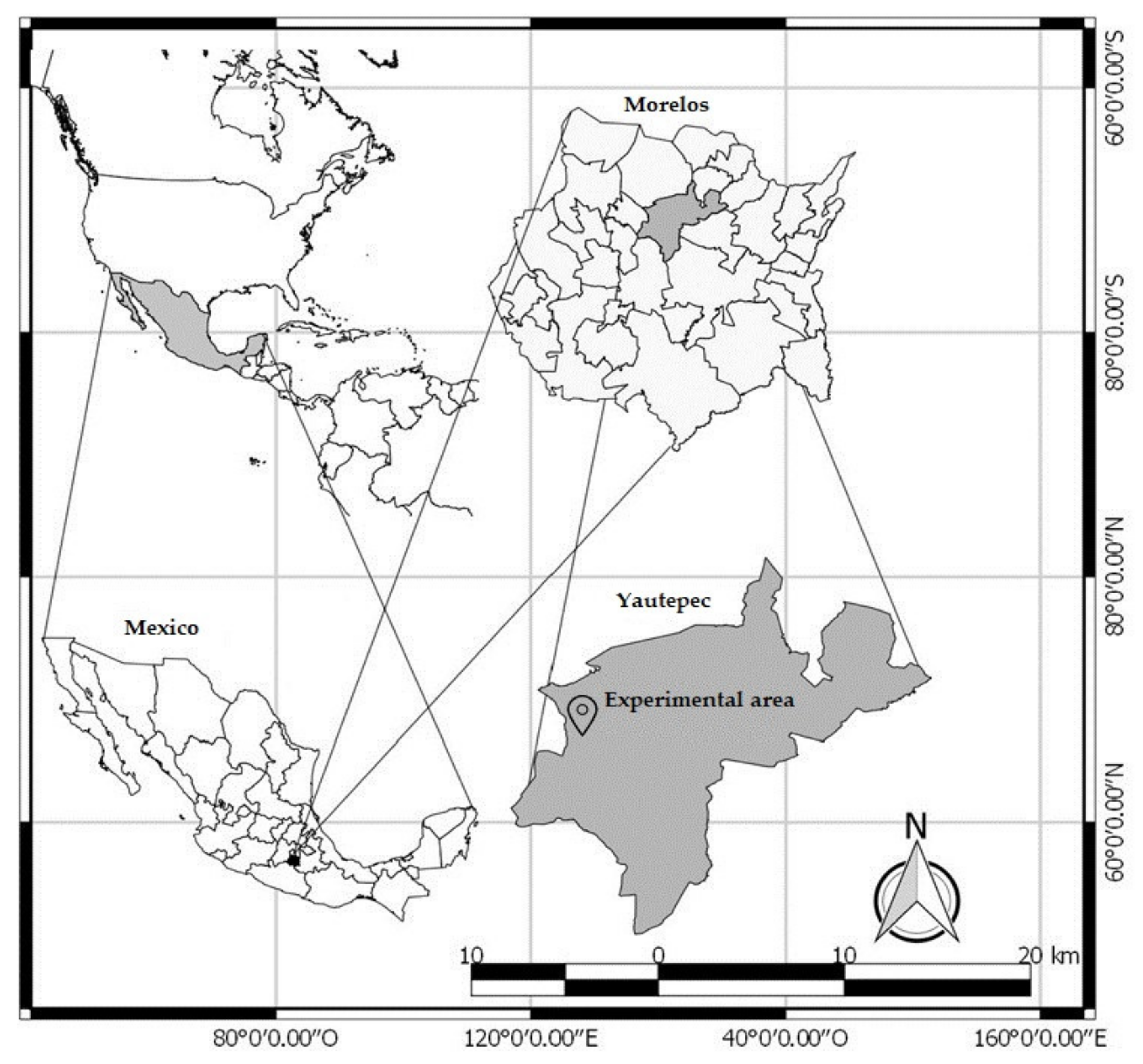
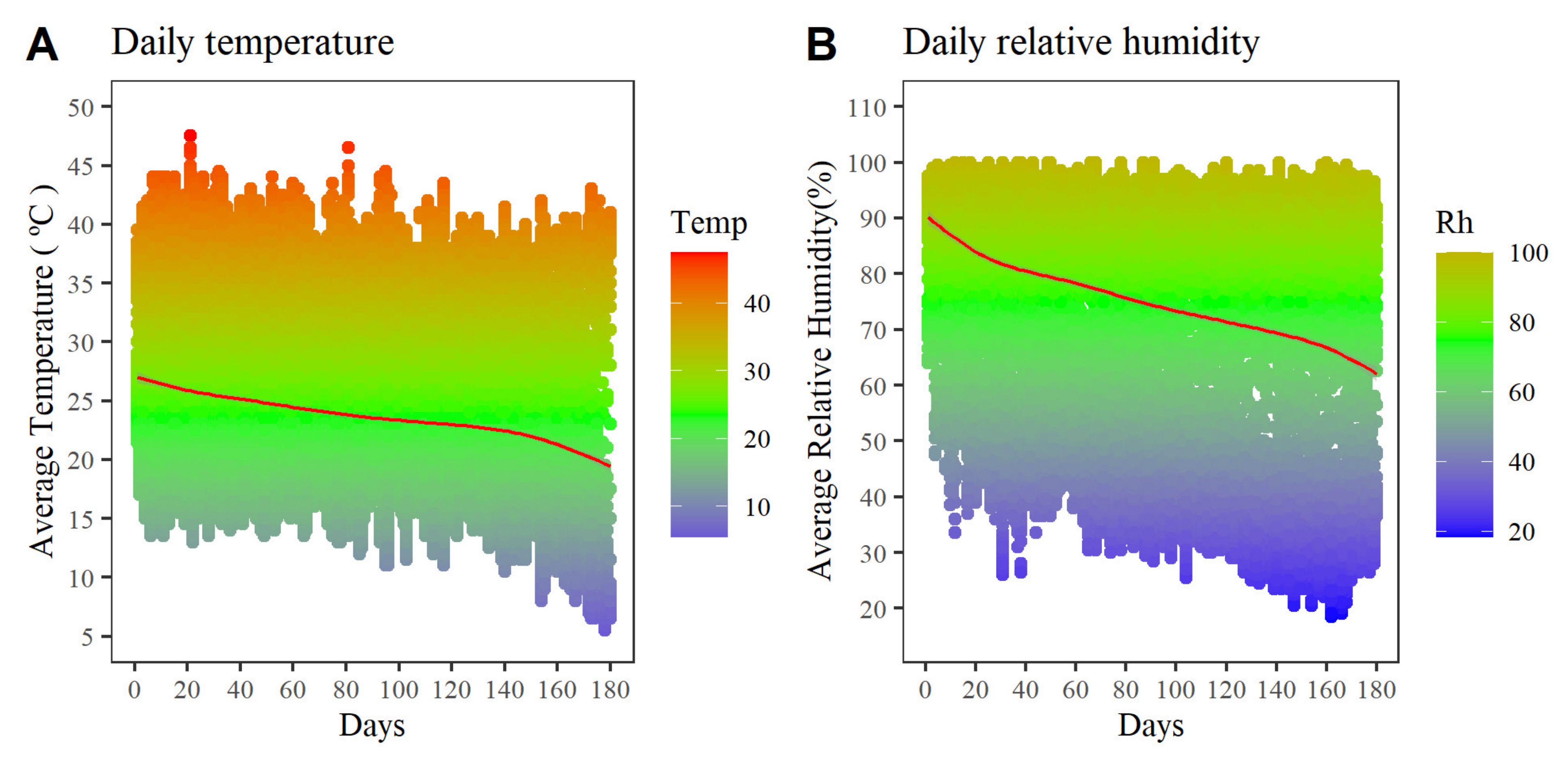
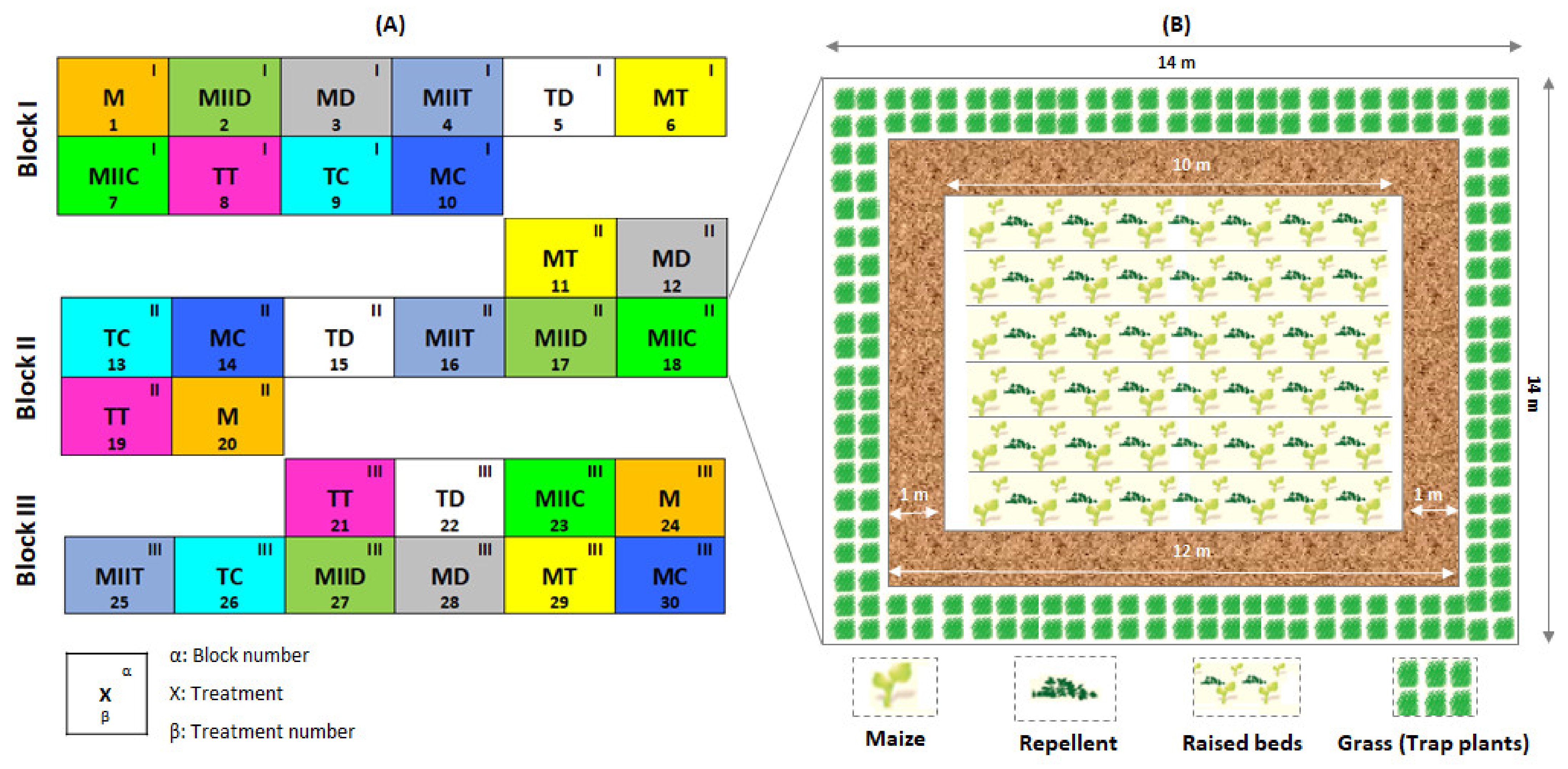
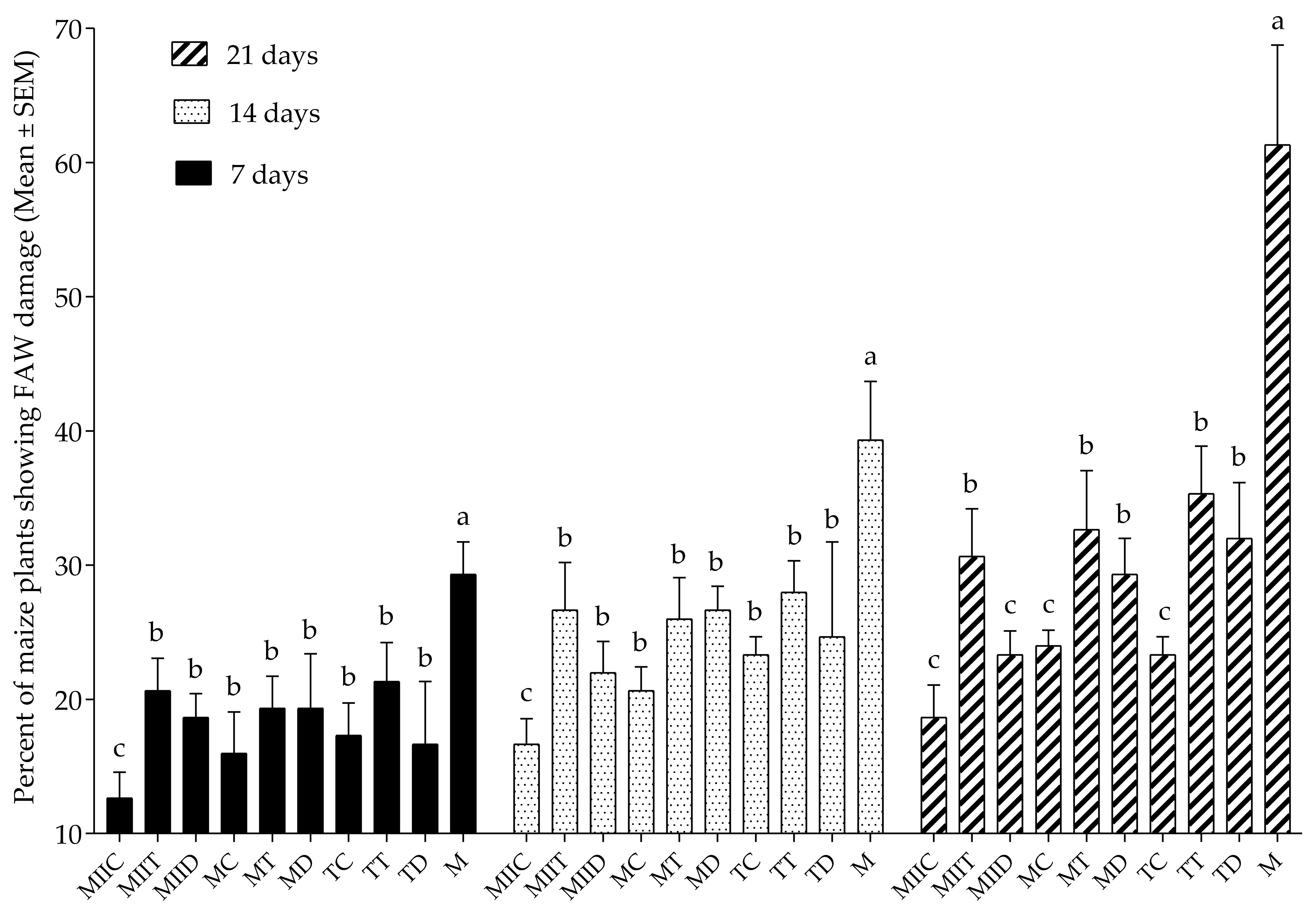
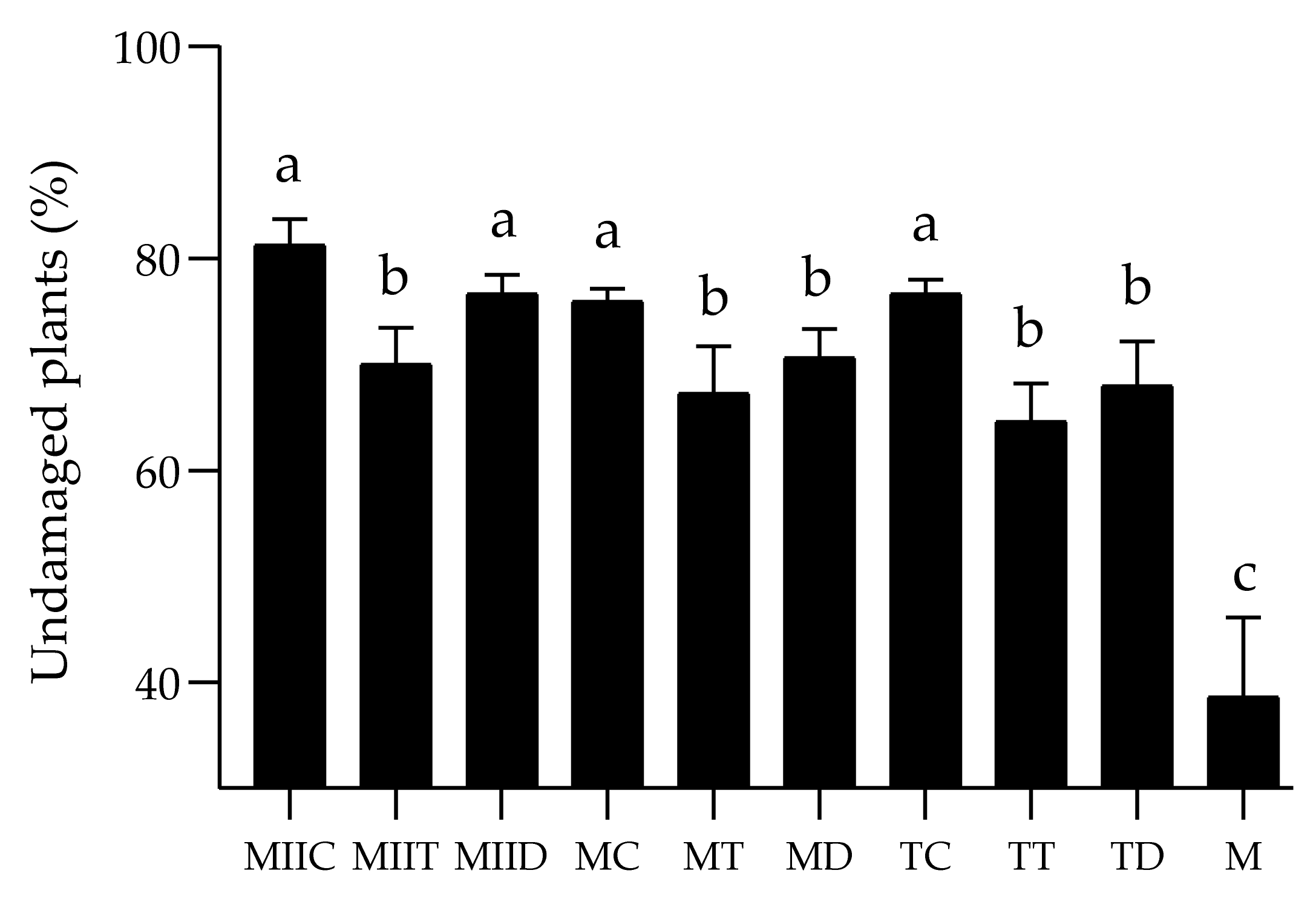
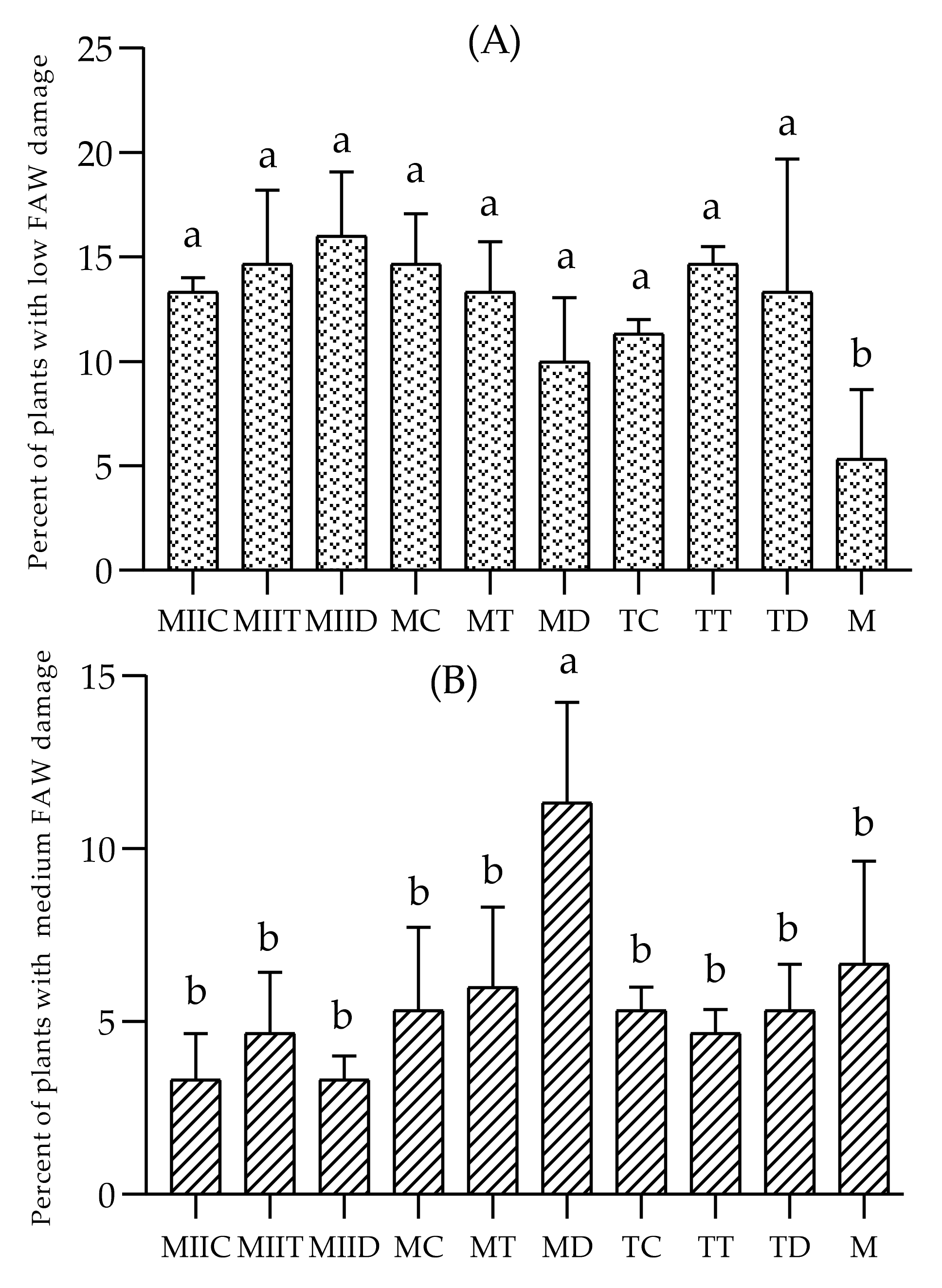
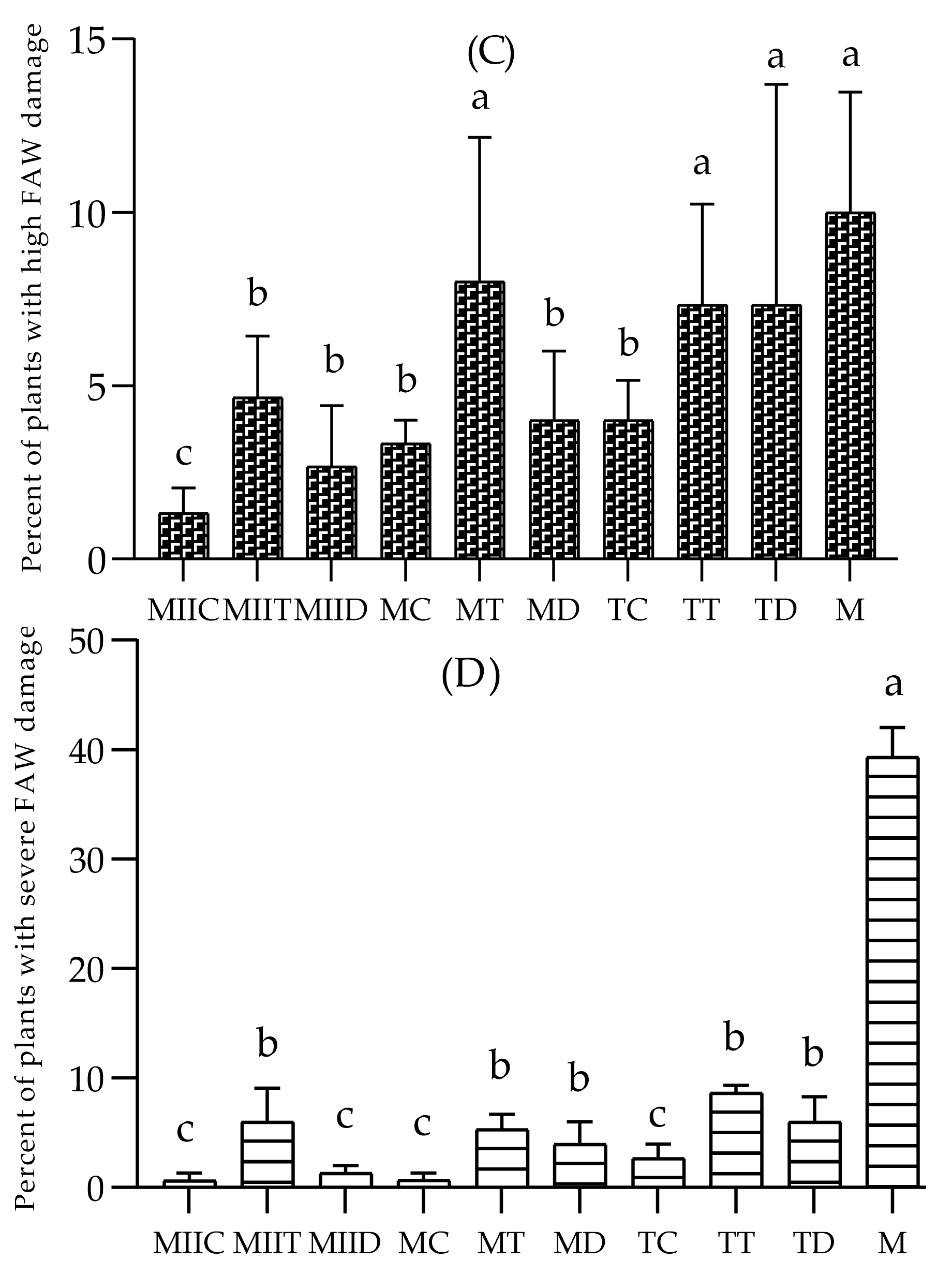
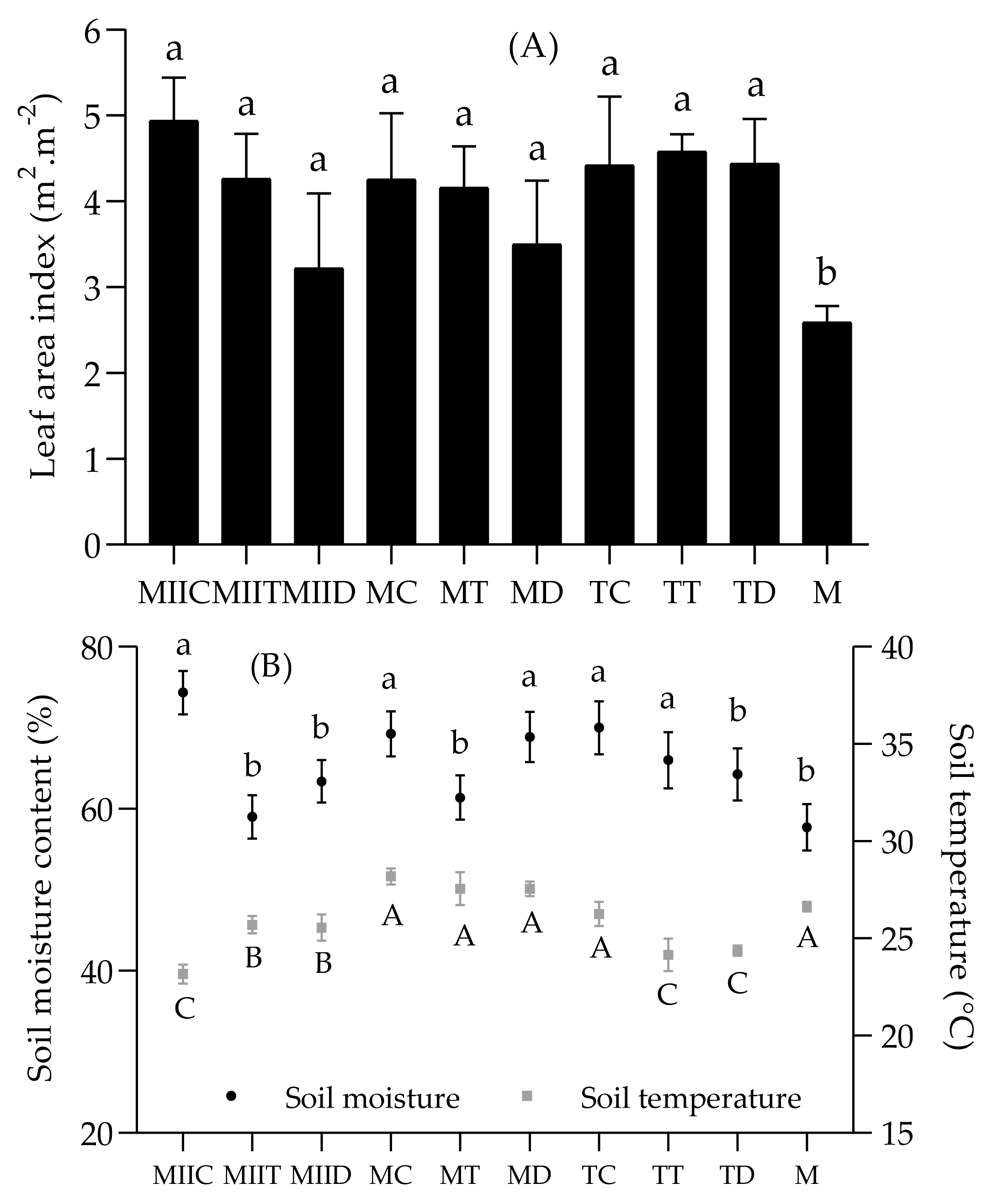
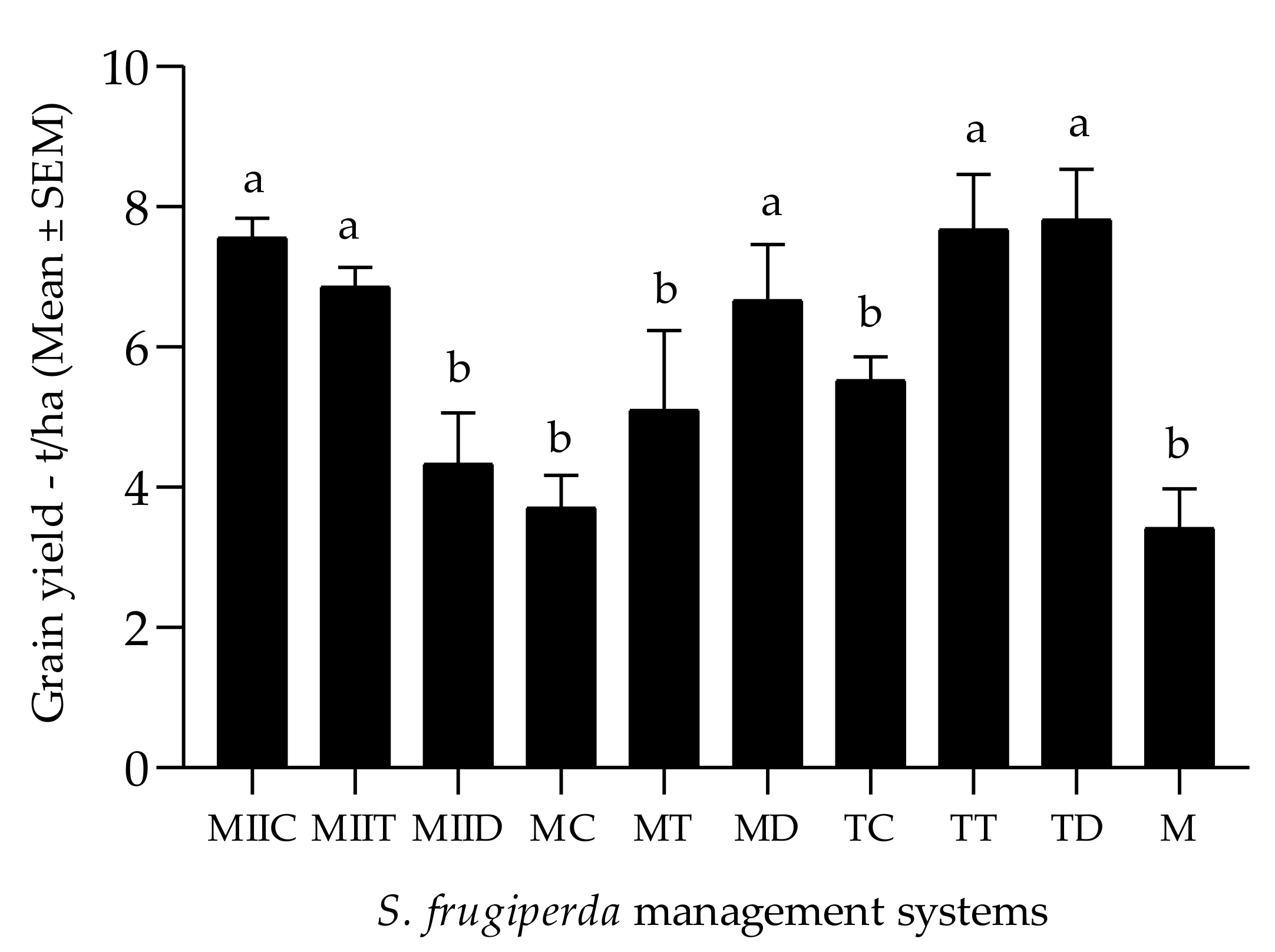

| System Codes | Components | Treatments | |
|---|---|---|---|
| Attractants ¥ | Intercrops * | ||
| MIIC | Brachiaria hybrid cv Mulato II | Crotalaria juncea | Mulato II & C. juncea |
| MIIT | Tagetes erecta | Mulato II & T. erecta | |
| MIID | Dysphania ambrosioides | Mulato II & D. ambrosioides | |
| MC | Panicum maximum cv Mombasa | Crotalaria juncea | Mombasa & C. juncea |
| MT | Tagetes erecta | Mombasa & T. erecta | |
| MD | Dysphania ambrosioides | Mombasa & D. ambrosioides | |
| TC | Panicum maximum cv Tanzania | Crotalaria juncea | Tanzania & C. juncea |
| TT | Tagetes erecta | Tanzania & T. erecta | |
| TD | Dysphania ambrosioides | Tanzania & D. ambrosioides | |
| M | - | - | Maize monoculture not treated with pesticides |
| Systems | Stem Diameter (cm) | Total Height (m) | Cob Diameter (cm) | Cob Length (cm) |
|---|---|---|---|---|
| MIIC | 2.43 ± 0.11 a | 2.54 ± 0.04 a | 5.40 ± 0.21 a | 24.22 ± 0.77 a |
| MIIT | 2.12 ± 0.09 b | 2.43 ± 0.03 a | 5.03 ± 0.17 a | 22.65 ± 0.40 b |
| MIID | 1.88 ± 0.12 b | 2.28 ± 0.06 b | 4.94 ± 0.20 b | 22.50 ± 0.49 b |
| MC | 2.09 ± 0.11 b | 2.18 ± 0.06 b | 4.65 ± 0.18 b | 22.62 ± 0.36 b |
| MT | 2.07 ± 0.16 b | 2.22 ± 0.07 b | 4.83 ± 0.17 b | 22.43 ± 0.49 b |
| MD | 2.06 ± 0.11 b | 2.34 ± 0.04 b | 5.28 ± 0.18 a | 23.22 ± 0.43 a |
| TC | 2.11 ± 0.13 b | 2.45 ± 0.03 a | 5.13 ± 0.12 a | 22.60 ± 0.37 b |
| TT | 2.42 ± 0.17 a | 2.40 ± 0.07 a | 5.35 ± 0.21 a | 23.39 ± 0.44 a |
| TD | 2.12 ± 0.09 b | 2.53 ± 0.04 a | 5.43 ± 0.12 a | 23.72 ± 0.50 a |
| M | 1.69 ± 0.19 b | 2.34 ± 0.05 b | 4.51 ± 0.23 b | 21.60 ± 0.60 b |
| System | Phytosanitary, Edaphoclimatic and Yield Criteria | Profitability Criteria | ||||
|---|---|---|---|---|---|---|
| FAIR (%) | FASR (%) | ASMR (%) | PPY/MY Ratio | NPV ($ USD) | Benefit/Cost Ratio | |
| MIIC | 69.56 | 58.61 | 28.81 | 2.21 | 1012.924 | 2.62 |
| MIIT | 50.00 | 47.05 | 2.20 | 2.00 | 1065.394 | 1.90 |
| MIID | 61.97 | 55.56 | 9.82 | 1.27 | 727.265 | 1.41 |
| MC | 60.87 | 54.88 | 19.99 | 1.08 | 266.900 | 1.45 |
| MT | 46.74 | 44.23 | 6.36 | 1.49 | 745.613 | 1.65 |
| MD | 52.17 | 47.50 | 19.30 | 1.95 | 1238.939 | 1.71 |
| TC | 61.96 | 52.72 | 21.25 | 1.61 | 623.801 | 2.02 |
| TT | 42.39 | 40.95 | 14.33 | 2.24 | 1250.677 | 2.06 |
| TD | 47.83 | 44.45 | 11.33 | 2.28 | 1452.002 | 1.82 |
| M | - | - | - | - | 518.703 | 1.59 |
Publisher’s Note: MDPI stays neutral with regard to jurisdictional claims in published maps and institutional affiliations. |
© 2021 by the authors. Licensee MDPI, Basel, Switzerland. This article is an open access article distributed under the terms and conditions of the Creative Commons Attribution (CC BY) license (http://creativecommons.org/licenses/by/4.0/).
Share and Cite
Guera, O.G.M.; Castrejón-Ayala, F.; Robledo, N.; Jiménez-Pérez, A.; Sánchez-Rivera, G.; Salazar-Marcial, L.; Flores Moctezuma, H.E. Effectiveness of Push–Pull Systems to Fall Armyworm (Spodoptera frugiperda) Management in Maize Crops in Morelos, Mexico. Insects 2021, 12, 298. https://doi.org/10.3390/insects12040298
Guera OGM, Castrejón-Ayala F, Robledo N, Jiménez-Pérez A, Sánchez-Rivera G, Salazar-Marcial L, Flores Moctezuma HE. Effectiveness of Push–Pull Systems to Fall Armyworm (Spodoptera frugiperda) Management in Maize Crops in Morelos, Mexico. Insects. 2021; 12(4):298. https://doi.org/10.3390/insects12040298
Chicago/Turabian StyleGuera, Ouorou Ganni Mariel, Federico Castrejón-Ayala, Norma Robledo, Alfredo Jiménez-Pérez, Georgina Sánchez-Rivera, Lilia Salazar-Marcial, and Hilda Elizabet Flores Moctezuma. 2021. "Effectiveness of Push–Pull Systems to Fall Armyworm (Spodoptera frugiperda) Management in Maize Crops in Morelos, Mexico" Insects 12, no. 4: 298. https://doi.org/10.3390/insects12040298
APA StyleGuera, O. G. M., Castrejón-Ayala, F., Robledo, N., Jiménez-Pérez, A., Sánchez-Rivera, G., Salazar-Marcial, L., & Flores Moctezuma, H. E. (2021). Effectiveness of Push–Pull Systems to Fall Armyworm (Spodoptera frugiperda) Management in Maize Crops in Morelos, Mexico. Insects, 12(4), 298. https://doi.org/10.3390/insects12040298








